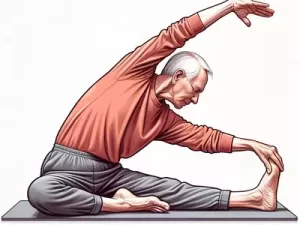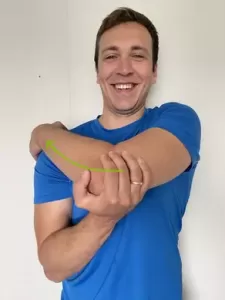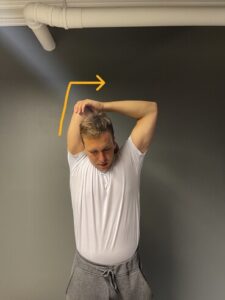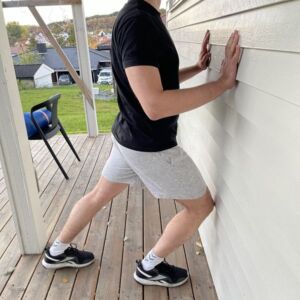5 Low Impact Stretching Exercises for Seniors
Key Points
- Low-Impact Stretching Benefits: Enhances flexibility, mobility, and balance for seniors.
- Aging Body Insights: Recognizing age-related changes helps choose effective stretches for seniors.
- Stretch Types: Differentiate between dynamic, static, and yoga stretches.
- Using Props: Chairs, bands, and yoga tools can aid in stretching.
- Safety First: Warm up, hydrate, and consult professionals when needed.
Let me show you 7 low-impact stretching exercises for seniors — a gentle yet effective way to keep your body in motion and your joints and muscles flexible.
5 Top Low Impact Stretches For Seniors
Overhead Side Stretch
- Stand tall with feet shoulder-width apart.
- Raise both arms overhead, interlocking your fingers.
- Gently bend to the left side, feeling a stretch along the right side of your torso.
- Hold for 15-30 seconds.
- Return to the center and repeat on the right side.
Shoulder Stretch
- Extend your left arm across your body at shoulder height.
- Use your right hand to gently press the right arm closer to your chest.
- Feel the stretch across your shoulder.
- Hold for 15-30 seconds.
- Switch arms and repeat.
Triceps Stretch
- Raise your right arm overhead.
- Bend the right elbow, bringing your hand down towards the upper back.
- Use your left hand to gently press on the right elbow.
- Feel the stretch along your triceps and the side of your arm.
- Hold for 15-30 seconds.
- Switch arms and repeat.
Hamstring Stretch
- Sit on the floor with your right leg extended straight and left leg bent, foot touching the inner thigh of the right leg.
- Keeping your back straight, lean forward from your hips towards the extended leg.
- Reach out with your hands towards your foot, ankle, or shin, wherever comfortable.
- Feel the stretch along the back of your leg.
- Hold for 15-30 seconds.
- Switch legs and repeat.
Calf Stretch
- Stand facing a wall with hands pressed against it.
- Step your left foot back, keeping the heel pressed to the floor.
- Bend your right knee slightly, keeping the left leg straight.
- Feel the stretch in the calf of the left leg.
- Hold for 15-30 seconds.
- Switch legs and repeat.
Why Low Impact Stretching?
Low-impact stretching is like the gentle whisper of the fitness world. It’s subtle but powerful. For seniors, it offers a myriad of benefits:
- Flexibility: Helps in daily tasks like bending or reaching out.
- Joint Mobility: Makes movements smoother and pain-free.
- Balance: Reduces the risk of falls, a common concern for seniors.
- Coordination: Enhances body awareness and posture.
Moreover, low-impact stretching can be a therapeutic experience. It’s not just about the body but also the mind.
Engaging in routines like the ones found on our stretching exercises for beginners over 50 can be a calming experience, almost meditative.
Understanding the Senior Body
The senior body is different. Muscles tend to lose their elasticity, joints might become stiffer, and the range of motion can decrease. But here’s the thing—it’s never too late to start. Understanding these changes can help you create a stretching routine that’s both safe and effective.
Myths Debunked:
- “Seniors shouldn’t exercise”: On the contrary, exercises like the ones on our dynamic stretches for older adults page prove that age is just a number.
- “Stretching can lead to injuries”: With the right guidance and techniques, stretching can be safe and beneficial.
Types of Stretches
here are various types of stretches, each with its own set of benefits:
- Dynamic Stretches: These are active movements where joints and muscles go through a full range of motion. They can be beneficial before starting a more rigorous exercise routine.
- Static Stretches: These involve holding a stretch for a short period, usually 15-60 seconds. They are great for cooling down after an exercise session.
- Yoga: A holistic approach to flexibility and strength. Yoga stretches for seniors can be low impact with high rewards. Dive deeper into this with our guide on stretching for seniors to improve posture.
Stretching with Props
Using props can enhance the stretching experience, making it more effective and comfortable. Here are some props seniors can incorporate:
- Chairs: Perfect for seated workouts, chairs offer stability and support. Our chair stretches for seniors guide provides a comprehensive list of exercises.
- Resistance Bands: These stretchy bands add a bit of resistance, enhancing muscle strength while stretching.
- Yoga Blocks and Straps: Ideal for those hard-to-reach stretches, they ensure proper alignment and safety.
Safety When Stretching as Senior
Safety is paramount, especially for seniors. Here are some precautions to keep in mind:
- Warm-up: Always start with a brief warm-up to prep the muscles.
- Listen to Your Body: If it hurts, stop. Stretching should feel good, not painful.
- Stay Hydrated: Drink water before and after stretching to keep muscles hydrated.
- Consult a Professional: Especially if you have underlying health conditions. Our stretching exercises for seniors with limited mobility offer safe options for those with mobility concerns.
The Role of Balance in Stretching
Balance and stretching go hand in hand. Improving balance can prevent falls and enhance overall mobility. Here are some exercises to try:
- Heel-to-Toe Walking: Walk in a straight line, placing the heel of one foot directly in front of the toes of the other foot.
- Single Leg Stand: Stand on one leg, holding onto a support if needed.
- Speed Drill: Tap your feet quickly in place, alternating between left and right.
Integrating Stretching into Daily Life
Making stretching a daily habit can be transformative. Here’s how to integrate it seamlessly:
- Morning Routine: Start your day with a quick stretch to awaken the body.
- Breaks: Take short stretching breaks, especially if you’ve been sitting for long. Our hip stretches for seniors are perfect for those desk-bound moments.
- Before Bed: A gentle stretch can help relax the muscles and improve sleep.
The Science Behind Stretching
Stretching is more than just elongating muscles. Let’s delve into the science:
- Muscle Fibers: Stretching helps in realigning disorganized muscle fibers, promoting healing.
- Joint Health: Regular stretching increases synovial fluid, keeping joints lubricated.
- Fascia: This connective tissue binds everything together. Our guide on fascia stretching for seniors dives deep into its importance.
Challenges in Stretching for Seniors
While stretching offers numerous benefits, seniors might face certain challenges. Let’s address them:
- Limited Mobility: Not all seniors have the same range of motion. Tailored exercises from our stretching exercises for seniors with limited mobility can be a game-changer.
- Health Concerns: Conditions like arthritis can make stretching painful. It’s essential to consult a professional and modify exercises accordingly.
- Lack of Motivation: Starting a new routine can be daunting. Joining a group or setting small goals can help.




